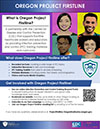What is Oregon Project Firstline?
Oregon Project Firstline is a new educational program that provides infection prevention and control education that is relevant to every healthcare worker, in every healthcare setting.
 Oregon Project Firstline, developed in partnership with the Centers for Disease Control and Prevention (CDC), is an educational program that gives foundational education on infection prevention and control (IPC) for all types of frontline healthcare workers. Oregon Project Firstline activities will help strengthen Oregon's healthcare workforce expertise in IPC, and help to keep the healthcare community safe from infectious disease threats.
Oregon Project Firstline, developed in partnership with the Centers for Disease Control and Prevention (CDC), is an educational program that gives foundational education on infection prevention and control (IPC) for all types of frontline healthcare workers. Oregon Project Firstline activities will help strengthen Oregon's healthcare workforce expertise in IPC, and help to keep the healthcare community safe from infectious disease threats.
For a brief description about our program and resources,
 download this flyer (pdf).
download this flyer (pdf).
Why is infection control important?
Understanding the basics of infection prevention and control is important for every healthcare worker. Watch this video to understand more:
Need infection prevention training?
Complete a request using our
Infection Prevention (IP) Training Request Portal. This training request portal allows our team to coordinate and tailor infection prevention education based on you and your colleague's learning preferences. This training request portal is open to all interested requestees from all education programs and health care settings including:
- Hospitals
- Long-term care facilities
- Adult care centers
- Hospitals
- Dialysis centers
- Community centers
- Universities
Access CDC Project Firstline material?
CDC is the leading partner in Project Firstline. To learn more, go to their Project Firstline website or follow the CDC Project Firstline.  Facebook
Facebook  Twitter
Twitter
Infórmese sobre el control de infecciones en la atención médica
Acquire infection prevention materials!
Are you an infection prevention educator? Please see the following links for useful Project Firstline materials for specifically educational purposes:
Interested in viewing the infection precention materials seen in Oregon Health Authority's past presentations? Access them here through the following links! All documents are PDFs.